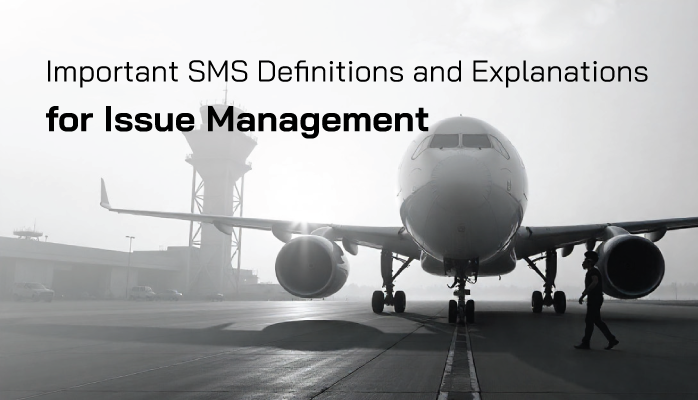Importance of Definitions for Safety Management System

Definitions are important.
Definitions guide us and help give structure to imprecise, vague, or nebulous risk management processes.
Having an accurate understanding of definitions allows us to have an accurate understanding of the structure of issues. Furthermore, it allows us to identify specific aspects of those issues and organize the issue however we please.
Generally, this organization includes:
- Qualifying the issue with classifications;
- Breaking down the issue into its logical stages;
- Understanding the sequence of events; and
- Understanding what went wrong and things went wrong.
During issue management, here is a list of critically important safety management system definitions and explanations.
What Are Hazardous Sources
Hazardous sources are otherwise harmless things in the environment from which the adverse flow of events starts. Some examples are birds, mountains, buildings, and chemicals. Hazardous sources become hazards through some kind of interaction. It’s the difference between:
- (Hazardous Source) tall building; and
- (Hazard) tall building in the flight path.
Hazardous sources and hazards are often confused.
What Are Precursors to Risk
Precursors to risk are existing Norms, attitudes, behaviors, business practices, and other underlying mechanisms that currently exist in your company. To put it another way, precursors are the positive/negative states of your company right now. Some examples are:
- “Showing up to work at all costs, despite being sick or tired”
- “Only reporting concerns if it seems absolutely necessary”
- “Report all potential concerns immediately”
Precursors are closely linked to aviation safety culture, though precursors can exist that are not safety culture (i.e., old machinery).
What Are Initiating Mechanisms and Root Causes

Also called Root Causes, initiating mechanisms are the events, interactions, and conditions that start an adverse flow of events that can eventually lead to hazard occurrence. Initiating mechanisms/root causes always involve the hazardous sources and are often motivated by existing conditions. General categories of root causes are:
- Faulty equipment (condition);
- Behaviors and choices (interaction);
- Changes in environment (event); and
- Breakdown in a particular process/procedure/task (event).
Some examples of root cause are:
- Miscalibrated runway light temperature;
- Dated map of runway;
- Unrestricted security locations (doors, pathways, etc.);
- Backup server in same location as main server; and
- Pilot working over prescribed duty time.
Related Articles on Root Cause Analysis in Aviation SMS
- Understanding "Root Cause Analysis" Charts in Aviation SMS Dashboards
- Is Root Cause Analysis Proactive or Reactive?
- Safety Chart: Monitor Root Causes' Contributing Factors in Aviation SMS
What Are Contributory Factors
Contributory factors are Human Factors, risk control factors, or other conditions that affect threat level:
- Negative effect: increasing the threat/danger/exposure level that leads to hazard occurrence
- Positively: decreasing the threat/danger/exposure level and preventing hazard occurrence
In most situations, there will be factors that contribute both positively and negatively, but whichever side (positive/negative) has more contributing factors will decide whether or not a hazard occurs.
What Are Hazards and Hazard Occurrence
A hazard is a condition, such as an object, situation, or circumstance, that poses an unacceptable level of danger. A hazard occurrence is when a hazard “actualizes,” or becomes real, in your operational environment. Upon hazard occurrence, immediate steps must be taken (by humans or risk controls) to mitigate the situation and prevent risk occurrence (adverse event).
Hazards are listed in your hazard register and are classified during issue management. A hazard that is classified helps qualify and summarize the hazard that actually occurred in the safety issue. Here’s an example:
- Hazard: “Ground object in flight path”
- Hazard Occurrence: Near miss after aircraft flew close to unlit telephone tower
How Mitigation Factors Work in SMS
Mitigation factors are Human Factors, risk control factors, or other conditions that affect the dangerous situation:
- Positively: threat level is brought back into an acceptable level of safety and does not lead to risk occurrence (adverse event)
- Negatively: threat level is NOT brought back into an acceptable level of safety and leads to risk occurrence (adverse event)
Mitigation factors are very similar to Contributory Factors, but it’s extremely useful to make the distinction between things that come BEFORE the situation reaches an unacceptable level of safety (hazard occurrence) and things that come AFTER the situation reaches an unacceptable level of safety (mitigation factors).
What Is Risk Occurrence

A risk occurrence is when an adverse occurs after a hazard occurrence. An adverse event causes damages to your company, such as:
- Injury/Death;
- Crash;
- Accident; or
- Damaged equipment.
A risk occurrence is the climax of situations that are not successfully mitigated.
Related Aviation Hazard and Risk Occurrence Articles
- What Is Risk vs Risk Occurrence in Aviation SMS
- Life Cycle of Hazard and Risk Occurrence in Aviation SMS
- How to Distinguish Hazard vs Risk Occurrence
Is There a Difference Between Consequences and Risk Occurrence
Consequences are the specific fallout from your risk occurrence, such as:
- Loss of reputation;
- Fines and legal action;
- Non-compliance fines;
- Financial loss.
The line between consequences and risk occurrence is often vague, but in general, consequences are quantitative (they have specific numbers attached to them), whereas risk occurrences tend to be more qualitative (they are described in a narrative). As an example:
- (Risk Occurrence) Aircraft very hard landing causing damage to tail assembly;
- (Consequences) Stock shares fall by $12 million after national media coverage of incident; tail damage cost of $1.2 million.
How Do Risk Controls Mitigate Exposure
Risk controls are resources you used to prevent, detect, and correct safety issues. These resources can be:
- People, such as by providing specific types of training
- Technology, such as by providing certain software
- Bureaucracy, such as with specific policies and procedures
Risk controls are implemented to act in two places in the issue life cycle:
- To control root causes from escalating exposure (usually detective and preventative controls); or
- To control hazard occurrence by preventing or mitigating risk occurrence (usually corrective and preventative controls).
How Do Human Factors Influence Outcomes
Traditionally, Human Factors and those factors “Dirty Dozen” are associated with negative human attitudes/behaviors that contribute to safety issues (and other types of issues). However, it’s a good idea to take a broader look at Human Factors as anything human-related that affects the outcomes of safety events.
This is because, while the Dirty Dozen is aptly named, it’s important to remember that humans are also your first line of defense. For example, where:
- “Good communication” can help a dangerous situation,
- “Lack of communication” can hurt a dangerous situation.
- “Teamwork” can help a dangerous situation,
- “Lack of teamwork” can hurt a dangerous situation.
Basically, this take on Human Factors allows for both POSITIVE and traditional (NEGATIVE) Human Factors.
To see how prepared your SMS is for proper issue management with this free SMS quality quiz.
Last updated September 2025.





